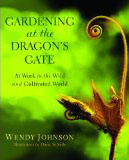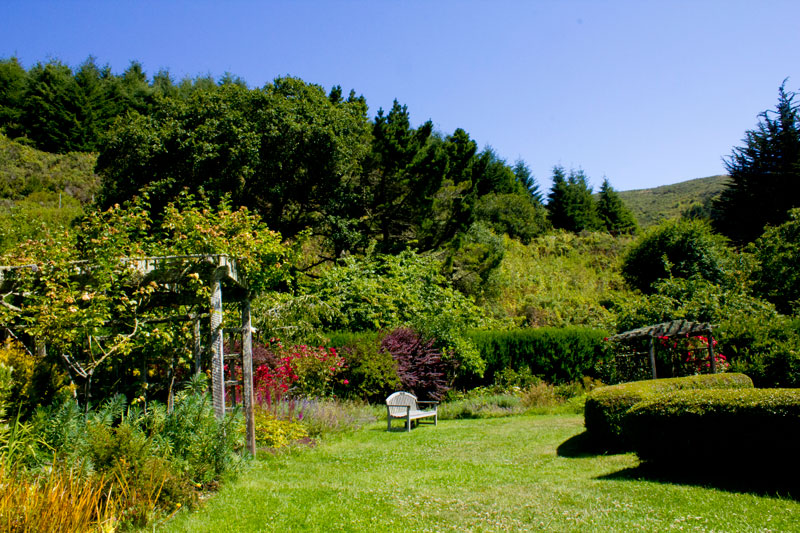Gardening at the Dragon's Gate
At Work in the Wild and Cultivated World
By Wendy Johnson
Bantam, New York, 2008

Wendy Johnson is a practitioner of Zen Buddhism who lived for twenty-five years at Green Gulch Farm, the San Francisco Zen Center’s property in Marin County, California. She first met Alan Chadwick briefly in about 1975, when he made a one-day visit to give a lecture. After that, she did not see him again until December of 1979 when, terminally ill with cancer, he returned to Green Gulch and stayed until his death in May of the following year. During those last six months of Alan’s life, Wendy, who by then had become the head gardener, and a small group of other Zen students met with Alan once a week for informal talks on various aspects of horticulture. She would sometimes bring questions about issues she was facing in the garden, and Alan, from his sick bed, would do his best to provide answers and to edify the group. It was an embarrassment for him to be unable to conduct these sessions in the garden, but the Zen students were respectful, and this helped to put Alan at his ease.
The mood had changed significantly at Green Gulch by the time of Alan’s return. Earlier, his interest in growing flowers along with the vegetables in the garden had been a source of irritation for the Zen authorities. By the time of his return in 1979, a much more balanced approach had taken hold, and this was at least partially a result of Wendy Johnson’s influence. No longer was it taboo to speak about roses, iris, or other flowering plants; about ornamental gardens or cut flowers. Alan’s aesthetic was more or less accepted without criticism, and this somewhat redeemed the treatment that he had received from the Zen Center seven or eight years earlier when the leadership had been concerned with vegetable production exclusively.
This unfortunate legacy was largely redeemed by the Zen Center welcoming Alan as a guest when he became terminally ill, and Wendy Johnson’s graciousness and her respect for Alan made a huge difference. Her generosity of spirit went a long way toward cleaning up any lingering hard feelings.
The title of her book, Gardening at the Dragon’s Gate, refers to the Japanese name for the Green Gulch Farm, which translates as, “Green Dragon Zen Temple.” The book is essentially a chronicle of her work at Green Gulch and the philosophical outlook that she brought to the discipline. Following a brief overview of Alan Chadwick’s life, she makes reference to Alan here and there, relating anecdotes and phrases that he had used during their weekly conversations. But this book is only peripherally about Alan. Mostly it is about Wendy’s personal attitudes toward nature, horticulture, and life: a view strongly influenced by Zen, but ultimately one that is uniquely her own.
She tackles some of the more difficult issues faced by philosophically-oriented gardeners: for example, how to reconcile an attitude that holds as sacred all forms of sentient life, but that also needs to eat. She correctly observes that the garden is a constant battle-ground between all the critters that want to use the garden as a source of food, and the gardener who wants the same. Gophers, cucumber beetles, sparrows—you name it—they must be promptly dealt with or you can forget your hopes of harvesting anything other than a few measly remnants. Wendy very honestly remarks:
“I wish that there were some way to garden without harming and taking life, but I do not believe that there is.”
Like Alan Chadwick, she advocates a balanced approach to pest management, including adequate fencing, building strong plant resistance through the development of healthy soils, encouragement of natural predators, and a willingness to share a portion of the crop with the natural world. Typically, organic gardeners find that these measures handle most of the problems. As for the rest, you just have to do battle.
The description that she gives of her work in various school-garden projects, and the healing effect that gardening brings to education, are insightful and inspiring. In recent years there has been a growing recognition of children who suffer from NDD, “Nature Deficit Disorder,” a malady that results from spending too much time inside buildings, on asphalt and concrete, or exposed to electronic media. We are children of nature and of life, and separation from the natural world—from running water, trees, grass, wild flowers, insects, soil, birds, animals—leads to a sense of isolation, depression, apathy, and anger. Gardening brings a strong healing effect to education, and deserves a place in the curriculum of every school.
The strength of Gardening at the Dragon’s Gate is that it is rooted in the direct personal observations and practice of the author. She speaks with the authority that comes with years of experience, wide study, good teachers, and deep thinking. Like all good students of Zen, Wendy spices her narratives with aphorisms quoted from famous Zen masters, and these often add a delightful levity to her writing. “Don’t say good; don’t say bad,” is one of the wisest, while “Life is one continuous mistake,” quoted from Suzuki Roshi, can remind us to forgive ourselves our many failures.
If this book falters at all, it would be in the one or two instances where the author departs from speaking out of her direct experience and falls into abstractions, as for example, in her discussion of fertilizers and chemicals. As Alan Chadwick pointed out many times, to put a name on something is not the same as to understand its essence. Scientific pedants, he said, pronounce the word “nitrogen,” and think they have said something intelligent. The truth is that none of them have the least idea of what they are talking about. If you want to form a meaningful concept of nitrogen, he once told me, imagine that you are walking in a lush green forest. Suddenly you come upon a clear mountain stream, sparkling in the sunlight. You then follow the little stream to its source and find that it flows out of a cave filled with crystalline rocks that shimmer like moonlight in the darkness. Entering the cave and following the luminous stream, you finally come to the source, a pool of water bubbling to the surface, tinged with a blue-green phosphorescence like that sometimes seen in sea water, shining and sparkling with the burst of every bubble. “That image, my dear boy, is as close as you will ever get to the essence of nitrogen,” he said.
Alan considered all glib talk of NPK (nitrogen, phosphorus, and potassium) as mere pedantry and verbosity—empty abstractions that kill any possibility of arriving at an in-depth understanding of the essence of healthy soil fertility. He once said,
"You can't know it. You can't understand it, and you mustn't try. Because the moment you try you can't perceive it. When you stop trying to understand it in words, you will begin to perceive it. You do begin to perceive it."
There is another way of knowing, but it is more visceral. By quietly observing the soil, feeling it, smelling it, noticing how various plants grow in it, deeply sensing the quality and quantity of microbial life, it is possible to gain an understanding of that soil’s fertility at an intimate level. Soil testing for NPK is just not necessary for organic gardeners.
One other issue is that Wendy Johnson seems to be unaware of the conflict that arose at Green Gulch back in 1972 and 1973 over the issue of flower cultivation in the garden. She attributes Alan's departure from the Zen Center as caused by Alan's complaints about the Zen students' meditation practices depriving him of garden workers, and repeats a story about how Alan throttled a blue jay that had torn up a seed flat. Those of us Chadwickians who worked at Green Gulch never observed either of those actions on the part of Alan. Attempts to contact Wendy to find out her source for those stories (she was not at Green Gulch at that time) have not yet been successful. Until we can discover her sources and verify the information, we remain somewhat dubious about these episodes.
Otherwise, Gardening at the Dragon’s Gate is an informative look at life from the point of view of a gardener who is also a deep thinker and devout Zen practitioner. Although the garden is a source of food, it can also be a profound teacher for the student who is sensitive to its subtle mysteries. In this sense, Wendy Johnson faithfully follows in the Chadwick tradition.

A view of the formal garden at Green Gulch designed by Skip Kimura, a former Chadwick apprentice.. (Photo by Will Haynes, 2012)
Return to the top of this page
